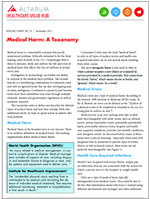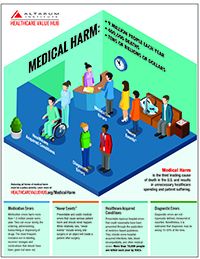Improving Value
Reducing Medical Harm - Financial Incentives and Disincentives
A critically important area of excess spending and patient suffering is connected to care that is not only unnecessary but actually harms patients. Among other things, medical harm includes serious reportable events—more commonly called “never events.”
The strategies that help reduce patient harm are fairly well-understood but unevenly implemented. Offering financial incentives or implementing disincentives to reduce harm is one policy tool to address patient medical harm and improve healthcare quality, increase patient confidence in our health system and reduce spending.
Financial Incentives or Disincentives
Financial strategies to reduce medical harm include implementing “pay-for-performance” and “non-payment for never events” policies.
Pay-for-Performance
Pay-for-performance (P4P), or value-based payment, aligns financial incentives and disincentives with provider performance. The Centers for Medicaid and Medicare Services (CMS) provides the most funding for P4P programs, followed by private insurers.1
There is an assumption that P4P programs will incentivize healthcare providers to improve the quality of their services and in turn, commit fewer medical harm events.2 However, thus far, the impact of broader P4P programs on medical harm reduction has not been thoroughly studied.
An example that has been studied is the targeted Hospital-Acquired Condition Reduction Program (HACRP), a CMS P4P program that targets hospital-acquired conditions (HACs). Under the HACRP, the Secretary of Health and Human Services (HHS) is required to adjust payments for the worst-performing hospitals. Specifically, hospitals that score in the 75th percentile of HAC scores, meaning they have higher frequencies of HACs, receive a 1 percent payment reduction.3
A study released in 2020 found that the HACRP program inadequately measured HAC events and was not effective in improving patient outcomes.4 It also disproportionately penalized teaching hospitals and hospitals that served socioeconomically-disadvantaged populations. As a result, researchers recommend that the HACRP program modify its HAC measures and improve risk adjustment so that hospitals can be more accurately compared.
Nonpayment for Never Events
“Never events” (also known as adverse events or serious reportable events) are events that should never occur in a healthcare setting.5 The National Quality Forum (NQF) has categorized never events into 7 different types, including harm such as performing procedures on the wrong patient, leaving foreign objects in a patient during surgery, causing patient injury or death through the use or administration of contaminated devices or drugs and more.6
In an effort to reduce instances of never events, many insurance entities have decided not to reimburse healthcare providers for certain never events.
In 2008, the Centers for Medicare and Medicaid Services (CMS) announced—starting in 2009-- it would no longer pay for:7,8
- pressure ulcers stages III and IV;
- falls and trauma;
- surgical site infections after bariatric surgery for obesity, certain orthopedic procedures, and bypass surgery (mediastinitis);
- vascular-catheter associated infections;
- catheter-associated urinary tract infections;
- administration of incompatible blood;
- air embolisms; and
- foreign objects unintentionally retained after surgery.
Blue Cross and Blue Shield, Cigna and Aetna insurance companies subsequently adopted nonpayment policies for selected never events.9
Some approaches are careful to protect patients from paying for the care that stemmed from a never event. For instance, members of Blue Cross and Blue Shield of New Jersey,10 Blue Cross and Blue Shield of Illinois,11 or Johns Hopkins Healthcare12 are held harmless for never event-related reimbursements that health plans do not pay. Aetna13 and Cigna14 require that providers waive patient charges related to selected never events.
Nonpayment for never events has shown promise as a strategy to reduce medical harm but is understudied. A 2017 JAMA Internal Medicine study looked at the change associated with the implementation of Medicare’s nonpayment policy and found significant reductions in the rates of central line-associated blood stream infections (CLABSIs) and catheter-associated bloodstream infections (CAUTIs). They did not find significant changes among the rates of hospital-acquired pressure ulcers (HAPUs) or injurious falls.15 A 2012 study that used a smaller sample size, however, did not find significant reductions in the rates of CAUTIs and CLABSIs after the implementation of Medicare’s nonpayment policy.16 Another 2017 study of CMS’ nonpayment policy, however, found a reduction in certain never events following implementation of the policy, with greater reductions among hospitals that served larger populations of Medicare patients.17
Non-payment has some detractors. A blog posted in HealthAffairs criticized the “business case” for patient safety, arguing the prioritization of patient safety should be driven by providers’ concerns for patient health rather than financial considerations.18
In sum, nonpayment for never events is a visible, relatively noncontroversial step that states can take to promote patient safety, in conjunction with other strategies.19 For example, states can leverage their purchasing power through Medicaid and state employee health programs. Surprisingly, a majority of states have not yet adopted this policy.20 Broad, aligned payment approaches to preventable medical harm across private, federal and state payers would go a long way to towards spurring system change.21
Notes
1. NEJM Catalyst, What is Pay for Performance in Healthcare? (March 1, 2018).
2. Abduljawad, Asaad and Assaf F. Al-Assaf, "Incentives for Better Performance in Health Care," Sultan Qaboos University Medical Journal, Vol. 11, No. 2 (May 2011).
3. Centers for Medicare & Medicaid Services, Hospital-Acquired Condition Reduction Program (HACRP), (Feb. 11, 2020).
4. Lawton, Emily J., Kyle H. Sheetz, and Andrew M. Ryan, "Improving the Hospital-Acquired Condition Reduction Program Through Rulemaking," JAMA Network (May 22, 2020).
5. National Quality Forum, Serious Reportable Events, (Accessed June 10, 2020).
6. National Quality Forum, List of SREs, (Accessed June 10, 2020).
7. Kuhn, Herb B., Letter to State Medicaid Directors Regarding Guidance Related to Coordination of State Medicaid Payment Policies, Center for Medicare & Medicaid Services (July 31, 2008).
8. DoBias, Matthew, "CMS Makes Never Event Nonpayment Rules Official," Modern Healthcare (January 2009).
9. DerGurahian, Jean, "Never-Ending Questions," Modern Healthcare (September 2008).
10. Horizon Blue Cross and Blue Shield of New Jersey, Never Events (Accessed June 10, 2020).
11. Illinois Health Agents, Blue Cross and Blue Shield of Illinois Announces Its Intent Not to Pay for Additional Costs Resulting from 'Never Events,' (Accessed June 10, 2020).
12. Johns Hopkins Healthcare, Policy Number: RPC.002 (Accessed June 10, 2020).
13. "Aetna Refuses Payment for Never Events, Requires Corrective Action," Fierce Healthcare (Aug. 26, 2009).
14. SuperCoder, Cigna Reimbursement Policy (Accessed June 10, 2020).
15. Waters, Teresa M., et al., "Effect of Medicare's Nonpayment for Hospital-Acquired Conditions Lessons for Future Policy," JAMA Internal Medicine (July 2017).
16. Lee, Grace M., et al, "Effect of Nonpayment for Preventable Infections in U.S. Hospitals," The New England Journal of Medicine (October 2012).
17. Thirukumaran, C.P., et al., "Impact of Medicare's Nonpayment Program on Hospital-Acquired Conditions," Medical Care, Vol. 55, No. 5 (2017).
18. Millenson, Michael L., "The Lurking Danger in the 'Business Case' for Patient Safety," Health Affairs (Dec. 2, 2019).
19. Phillips, Diana, "Medicare's Nonpayment Policy May Be Working," Medscape (Jan. 8, 2015).
20. Ibid.
21. In 2008, Medicare implemented the Hospital-Acquired Conditions (HACs) Initiative, a policy denying incremental payment for 8 complications of hospital care, also known as never events. See: Rosenthal, Jill, and Carrie Hanlon, Nonpayment for Preventable Events and Conditions: Aligning State and Federal Policies to Drive Health System Improvement, National Academy for State Health Policy (December 2009).








